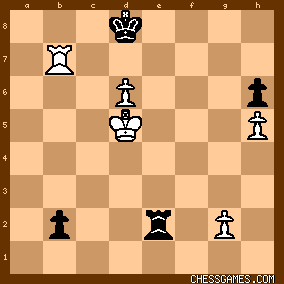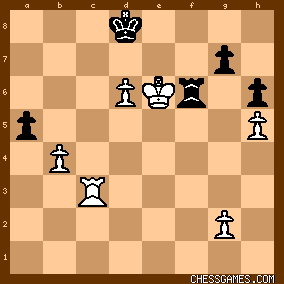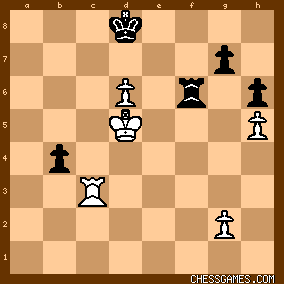|
< Earlier Kibitzing · PAGE 3 OF 3 ·
Later Kibitzing> |
| Jul-12-08 | | D4n: (Zooter) I wanted to play Rf3 too. |
|
| Jul-12-08 | | kevin86: The problem with 44 ♖f3 is the reply ♔e8-the point is that white has no move to threaten mate (c3 and a3 are barred by the black pawn at b4). The text is used to set up 45 ♖c4-the only way to get to that file is via the fourth rank. Attacking the pawn on b4 is incidental. |
|
Jul-12-08
 | | Breunor: HannibalSchlecter: why on earth on move 38 does black not play Kf6 to keep white's king away? Hmm, this made me think. I think Gelfand still wins. 38 Kf6 39 Ke4.
If black plays 39 Kb5?, White plays 40 Ke5 and picks up the e pawn. Similarly, if black plays 39 .... b4, white plays 40 Rf3 ch and black must play Kb5 and again white plays 41 Ke5. If black plays 39 e5, I supect white plays 40 Kd5 and again the black king gets shut out, and white threatens Kc6 pushing the pawn through. |
|
Jul-12-08
 | | al wazir: <MostlyAverageJoe: 45...Kd8 46.Rc5
with the idea of getting to the a-file with the usual threat.> Thanks. The trick is to get the timing right: 46...b3 47. Ra5 Kc8 48. Ra8+ (48. d7+ Rxd7 49. Ra8+ Kb7 50. Ra3 Rd3) Rb8 49. d7+ Kc7 50. Rxb8 (50. d8=Q+ Rxd8) Kxb8 51. d8=Q+. <Jason Frost>: In your line, why would black play 47...hxg5? After 47...b3 48. Rc7 b2 49. Rxg7 (or 49. gxh6 gxh6, etc.), 49...Kc8 wins. |
|
| Jul-12-08 | | johnlspouge: Saturday (Very Difficult): White to play and win.
Material: Even. White has mating threats against Kd8. There are no immediate tactical strokes, so a strategic plan is required. The Black K is subject to mate threats when on c8 (temporarily, because of Rb7), d8, e8, or f8. The Black Pg7 takes away a flight square from Kd8 and cannot advance without immediate loss hxg6 and creation of a White passed Pg6. The White Rg3 has access to the invasion point f8 to the right of Kd8, but on the 3-rd rank, because of Pb4, Rg3 has no access to the left invasion point on the 8-th rank (e.g., a8) that would force an immediate win. White must leverage mate threats into tempi to restrain the Black Pb4, to advance Pe6, and to capture Pg7 and/or Ph6. Candidates (44.): Rf3, Rg4
44.Rg4
This counterintuitive move renders the Black Rb7 immobile. White aims to move his R to the 7-th rank, forcing the Black K to the b- or g-file to escape the mate threats. As the variations below show, if the K escapes to the b-file, the Black K-side Ps fall; and if to the g-file, the White R can cut the Black K off long enough for the White K to control e7 and force d8=Q without the aid of the White R, which can then sacrifice itself with impunity for the Pb4. If Black does not play 44…b3 (e.g., 44…Ke8), Rg4-c4-c5 gains access to the a-file and then the 7-th rank anyway, and play proceeds as below. 44…b3 45.Ra4 (threatening 46.Ra8#)
45…Rb1 [Kc1 46.Ra8+ Rb8 47.d7+ Kc7 [or Kb7] 48.Rxb8 Kxb8 49.d8=Q+] 46.Ra7 (threatening 47.Rxg7 48.Rg8#)
The Black Pg7 must fall. To meet the threat 47.Rxg7, Black can counterattack: (1) 46…b2 47.Rxg7 Kc8 48.Rg8+ Kb7 49.Rxb8+ Kxb8 50.d7 b1=Q [Kc7 is no better] 51.d8=Q+ K moves 52.Qd5
White defends both Pg2 and Ph5 and cuts the Black K off from the K-side. Black cannot prevent the White K from approaching Ph6. After Ph6 falls, White has a slow but certain win with Q+2Ps vs. Q. Black can also frustrate the threat 47.Rxg7 directly: (2) 46…Ke8 [Kc8 47.Rc7+ is an transposition into (1) with Pb3 instead of Pb2] 47.Rxg7 Kf8 48.Rf7+ Kg8 [Ke8 49.Rh7]
49.d7 (threatening 50.Rf1 51.Rxb1 52.d8=Q+)
Because the White K controls e7, the best choice for Black is a losing Q+P vs. R endgame. |
|
Jul-12-08
 | | Jimfromprovidence: This was an excellent, subtle puzzle.
As an aside, 43...Rf2 instead of Rb7 sure looks like a draw. 
click for larger viewOne potential continuation is 44 Rxg7 Re2+ 45 Kd5 b3 46 Rb7 b2 and black looks in good shape. 
click for larger view |
|
| Jul-12-08 | | nosh: <johnlspouge> There's a much better line for 44 ... b3 that doesn't let Black queen the pawn. 44 Rg4 b3 45 Ra4 Ra8 46 Rf4!
Now to prevent mate, Black has to move his king allowing a check with the pawn and eventual trade of rooks allowing White's pawn to queen with check. |
|
| Jul-12-08 | | johnlspouge: To understand intuitively why 44.Rf3 is undesirable, the Black R can block mate threats on the a-side, so most of White's advantage derives from mate threats on the h-side. The move 44.Rf3 only forces Black to strengthen his defenses on the weak h-side with 44...Ke8. I agree with <Jimfromprovidence>, that this puzzle is very instructive. The mate threats leveraging the advance of Pd6 and Ke6 here could occur in many R+P endings. |
|
| Jul-12-08 | | johnlspouge: <<nosh> wrote: <johnlspouge> There's a much better line for 44 ... b3 that doesn't let Black queen the pawn.
44 Rg4 b3 45 Ra4 Ra8 46 Rf4!>
Nice catch! I wondered why Lerner did not try the loss I described, which seemed better than the game line. Thanks, <nosh>. |
|
| Jul-12-08 | | jmuller: <Jul-12-08 mpl: The point of 44.Rg4...> Thanks, mpl. I understand the position, now. :-)
I've enjoyed endgame week this week. :-) |
|
| Jul-12-08 | | alphee: Amazing and instructive, in fact the black rook got too many things to take care of. I was miles away from it. |
|
Jul-12-08
 | | Jimfromprovidence: Another strategy black may have employed was 42...Rf6+, knocking the king back to the fifth rank. 
click for larger viewNow, assuming 43 Kd5, black then plays 43...axb4.

click for larger viewHis position is more flexible and in a better position to draw. |
|
| Jul-12-08 | | belgradegambit: < nezhmet: 47. ...Rb6 draw> 48. Rg8 mate |
|
| Jul-12-08 | | 234: Friday puzzle Jul-11-08 <54. ?> Speelman vs Sax, 1988 |
|
| Jul-12-08 | | Marmot PFL: Gelfand gave the drawing line for black as 43...Rf6+ 44.Ke5 Rf2 45.Rxg7 b3 46.g4 b2 47. Rb7 Kc8. |
|
| Jul-12-08 | | DarthStapler: I didn't get it |
|
| Jul-12-08 | | Jason Frost: <belgradegambit: < nezhmet: 47. ...Rb6 draw>
48. Rg8 mate>
Rg8 dosen't exist whites rook is on f1 blacks King is on e8. 47...Rb7 is also a draw |
|
| Jul-12-08 | | Jason Frost: <al wazir> Black is lost either way if 47...b3 white plays 48. Ra4 not 48. Rc7?? 48...Rb8 49. gxh6 opening up the g file for the rook and winning |
|
| Jul-12-08 | | TheaN: 6/6
Yes! A saturday for once in a while!
I don't know if I can claim full point completely though, but I think I can: I saw that 44.Rf3 did not work due to Ke8 (losing the opportunity of the free 4th rank), so I noticed whether Rg4, not threatening the mate, had merit. And it seems like it was zugzwang. --A--
44.Rg4!?
Great move, exploiting the paralyzed position of Black whom cannot really move freely, with anything. Although the move looks strange, it's actually the only move to win (now I am right YouRang :)). 44....Kc8
Among others, but seems, after evaluation, the most challenging. Any Black try seems hopeless. I've discluded the seventh rank Rook moves as variations: it can't move along the 7th rank as it loses b4 (the only good pawn of Black) with mate threats and thus the game. Moving the g-pawn is hopeless as well, in view of the same threats after RxP. Black has three feasable alternatives to moving the passed pawn. --B--
44....Rb5
Or anywhere on the b-file to keep the b-pawn on but avoid a King move. 45.Rxg7
Rook = eat = free pawn.
45....Kc8
No matter what the Rook move was along the b-file, it's all forced now. 46.d7+
46....Kc7
Kd8: Rg8+ with forced promotion. That happens nonetheless. 47.Rg8
Promotion with check incoming, and if needed White can give his Rook for the b-pawn, but the position won't go that far.  --C--
45....b3
Had it as main line, but Kc8 with Kd8?! is actually more challenging and forces White to use the whole idea. 45.Ra4
Marching with the b-file infantry reveals a4 for the Rook, a decisive square for White. Mate is threatened (Ra8+, and Black can only do one thing. 45....Rb8
46.Rf4!!
Key move! White combines two ideas and has Black forced to make a losing move (Rb8): now, with the Rook gone of the second rank, Black can no longer defend against d7, and Black is once again threatened with mate. The continuation is in the main line  --D--
44....Ke8
Last but not least, the played variation. Actually, this goes to almost the exact variation as the side variation of the main line (-A-A-, see below or next post) but it's necessary to see the weaknesses after this King move. 45.Rc4
Threatening mate.
45....Rb8
Kd8 here gets us to main variation (A) move 46 White. 46.Rc7
The Rook marches in and now aims at the weakness that is g7. Take not that Rf4? now, will not threaten mate as the King is not on d8, and Black can play Rb7 to defend d7. 46....Kf8
Moving the g-pawn is useless, as is moving the Rook with a waste of a move (or ‡ >_>). So Black can only protect the pawn. Take note that b3 now will allow Rxg7 with unnecessary pawn loss. --D----A--
46....b3
47.Rxg7
47....Kf8
Avoiding mate.
48.Rf7+
Although the played variation, it seems to lose a pawn for nothing as all the other Black moves afterwards lead to the position with the g-pawn still on the board. See (D). --D--
47.Rf7+
47....Kg8
Ke8 and d7+, with major  . .
48.d7
48....b3
49.Ke7
Although the King seems more decisive on e7 (as it ends on e6 upon b2 in the -D-A- variation), White needs to play it anyway to promote, and needs to go back to stop the b-pawn also. 49....b2
50.Rf1
Nonetheless, even with the g-pawn, the b-pawn will be stopped and the d-pawn of White will Queen, either as full Queen or for the Black Rook.  |
|
| Jul-12-08 | | TheaN: --A--
45.Rc4+
Main line after 44....Kc8, which seems weird. But Black's next move cracks White's idea by avoiding mate threats. Black is faced with going back, losing two tempo, or going through to b8.45....Kd8?!
Although wasting moves and seeming unlogical, it might pose White with some breaking difficulties. Lets look at b8 first. --A----A--
45....Kb8
46.d7
Black is lost. He gave up control of d8 and will pay for that. Promotion, with control of the b-pawn, cannot be prevented on at least the next move (so Black has no time to play b3 and b2 with the threat of b1=Q).  --A--
46.Rc5!
Combining the ideas using the ranks, as in the (C) variation. Black didn't yet move the b4-pawn as he wasted two moves, and White transposes his idea to the fifth rank, threatening Ra5 suddenly. 46....b3
What else? Rb8 allows immediately the move that comes on 48. Take note that we are ALMOST in the (C) variation, but the Rook is on the fifth rank. 47.Ra5
47....Rb8
Avoiding mate.
48.Rf5!!
And from here, White's position is almost identical to the (C) variation, albeit this one is actually two moves longer and thus harder to crack. The mate is threatened, and the Rook on the 4rd or 5th rank is no stopper of the mate, so the variations are alike from here. 46....Kc8
Toughest. Ke8 leads to d7+ with the King back to d8 and a tempo gaining check on f8. After Rxb8 then, it's over. --A----B--
46....Ke8
47.d7+
47....Kd8
48.Rf8+
48....Kc7
49.Rxb8
 --A--
47.Rf8+
It's over...
47....Kb7
48.Rxb8+
48....Kxb8
49.d7
Keeping the King busy, Ke7?? would allow b2, unnecessarily drawing. 49....Kc7
50.Ke7
d8=Q with check and Qd1 next moves, stopping b2. Maybe not the best counterplay as main variation, but ah it was the most moves. I don't care anyway, I got a Saturday and got all the variation. SUNDAY, BRING. IT. ON!  |
|
| Jul-12-08 | | TheaN: I would like to note that I see a lot of people post the variation: 44.Rg4 b3 45.Ra4 Rb8 46.Ra7? which does not win: b2 47.Rxg7 Kc8!... If d7+, Kc7 keeps tabs on d8. If Rg8+, Kb7 makes it very hard for White, as b2 will promote before d6. This is in variations: 48.Rg8+ Kb7 49.Rxb8+ Kxb8 50.d7 b1=Q 51.d8=Q+ and White has a hard time. This also count for the Kc8, Kd8 variation as I've showed as main line in my posts. |
|
| Jul-12-08 | | Jason Frost: <TheaN> Not sure who posted that line, although technicly I think the Q + 2P v Q+P endgame is won, obviously instead of 46. Ra7 white should play Rf4 with and obvious win to follow |
|
| Jul-12-08 | | patzer2: For today's Saturday puzzle solution, Gelfand's 44. Rg4!! wins a difficult, and, surprisingly tactical, Rook and pawn endgame: <44. Rg4!!>
The purpose of this surprise move is to put Black's weak King and overworked Rook into a near Zugzwang situation, where any move decisively weakens his position. This move also indirectly pins Black's b-pawn, which further emphasizes the point that Black is practically forced to make a losing King or Rook move. <44...Ke8>
This near forced weakening move is about as good as any available to Black, since any Rook move drops one of the threatened pawns and gives White a winning advantage. One key point of 44. Rg4!! is that the reply 44... b3 loses to the mate threat created by 45. Ra4!, when, afterwards, play might continue 45...Rb8 (45... Kc8 46. Ra8+ Rb8 47. d7+ Kc7 48. Rxb8 Kxb8 49. d8=Q+  ) 46. Rf4! Ke8 47. d7+ Kd8 48. Rf8+ Kc7 49. Rxb8 Kxb8 50. d8=Q+ ) 46. Rf4! Ke8 47. d7+ Kd8 48. Rf8+ Kc7 49. Rxb8 Kxb8 50. d8=Q+  . . The Rook move 44... Rb8 loses immediately to 45. Rxg7  . . <45. Rc4! Rb8>
White's threatened mate practically forces this reply.
If 45... Kd8, White wins after 46. Rc5! Rb6 47. Ra5! Kc8 48. Ke7 Rb7+ 49.
Ke8 Rb8 50. Ra7 Rb6 51. d7+ Kb8 52. Ra6 Rxa6 53. d8=Q+ Kb7 54. Qe7+ Kc6 55. Qxb4  . . Other tries here lead to a quick mate, as, for example, after 45...Rd7 46. Rc8+ Rd8 47.
d7+ Kf8 48. Rxd8#.
<46. Rc7! b3>
This appears to be White's only winning try here. Because of the mate threats this move revives, and his strong passed d-pawn, White can attack immediately on the seventh rank, and safely ignore Black's passed b-pawn for at least a few moves. From here it's just a matter of simple technique for White to score the full point. <47. Rxg7 Kf8 48. Rf7+! Kg8 (48... Ke8 49. Rh7  ) 49.
d7 b2 50. Rf1 Kg7 51. Rb1 Rb6+ 52. Ke7 Rb7 53. Ke8> 1-0 ) 49.
d7 b2 50. Rf1 Kg7 51. Rb1 Rb6+ 52. Ke7 Rb7 53. Ke8> 1-0 |
|
| Jul-13-08 | | TheaN: <Not sure who posted that line> Well, something in that matter (I'm not going to look through all responses) that lets the b-pawn go too far leads to either Q+2P vs Q+2P/Q+P which would become quite difficult for White. Especially if White can force Q vs R with less moves. <45. Ra4!, when, afterwards, play might continue 45...Rb8 (45... Kc8 46. Ra8+ Rb8 47. d7+ Kc7 48. Rxb8 Kxb8 49. d8=Q+ )> Well wouldn't you know, I forgot that variation although I did see the win after Kc8. Well, for those who were wondering; the correct variation is this >_>... No, seriously now, I really got this one as it is actually the same as from the other side, after Rf4 or Rf5, oddly enough. White gains a tempo with d7+, and grabs the Rook on b8 with Kxb8 forced and d8=Q+, with the b-pawn nowhere to be seen near b1 yet (b3). |
|
| Oct-22-20 | | SpiritedReposte: <44. Rg4!> |
|
 |
 |
|
< Earlier Kibitzing · PAGE 3 OF 3 ·
Later Kibitzing> |
|
|
|





































